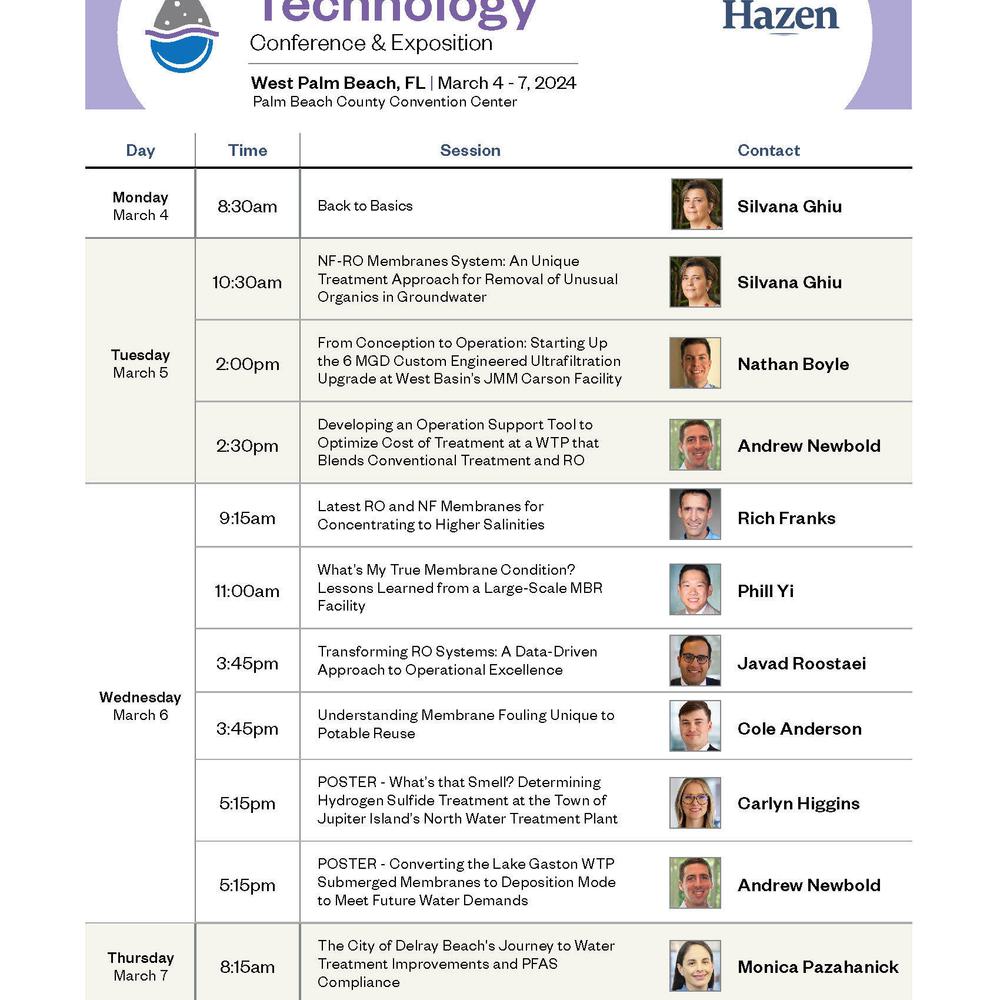Managing Groundwater Contaminants: Solutions for our Fastest Growing Source
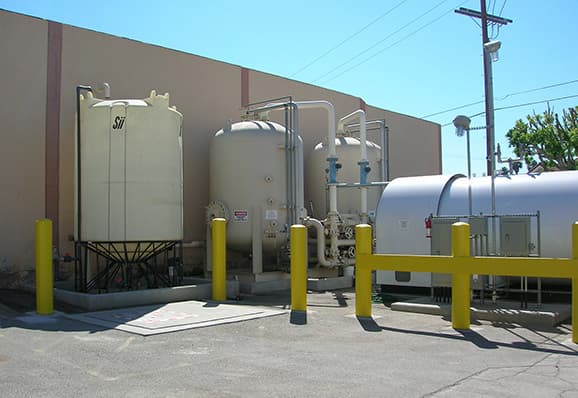
The City of Glendale (CA) managed a major research effort to identify technologies for removing hexavalent chromium, Cr(VI), from drinking water supplies.
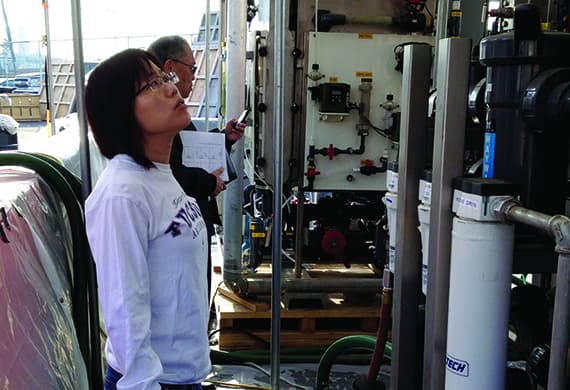
Ying Wu of Hazen and Sawyer inspecting a microfiltration (MF) unit tested as part of the RCF process.
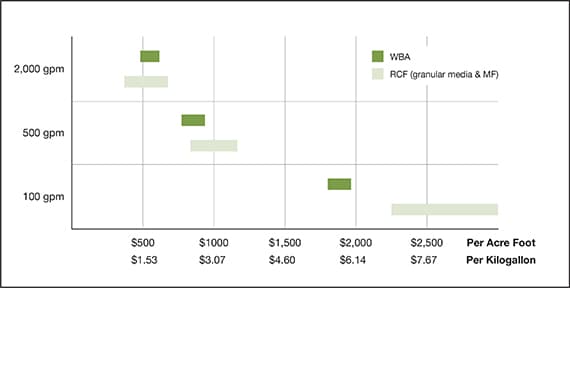
A comparison of the estimated annualized costs of the WBA and RCF technologies. Costs are for 100% utilization of treatment and the range reflects potential treatment goals of 1 ppb (high end) to 25 ppb (low end).
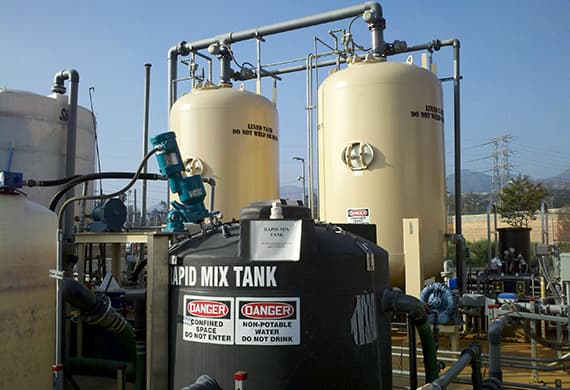
Reduction/Coagulation/Filtration (RCF) treatment process showing the pressure filters in the background and rapid mix tank for coagulation (100gpm). Components not shown include reduction tanks and aeration.
The City of Glendale (CA) managed a major research effort to identify technologies for removing hexavalent chromium, Cr(VI), from drinking water supplies. When the project began almost a decade ago, the City of Glendale was planning to take delivery of treated groundwater from a new water treatment plant. After delivery of the treated water to Glendale’s residents was approved, the City Council became very concerned with the presence of any Cr(VI) in their water supplies, even though the concentration was far less than federal and state water quality standard maximum contaminant levels (MCLs) for total chromium in water supplies. The City soon realized that there was no proven feasible technology for low-level Cr(VI) removal from water.
A research program led by the City, in partnership with many other agencies and organizations, has identified a handful of effective treatment technology options for removing Cr(VI) in drinking water, including reduction/coagulation/filtration (RCF), weak base anion exchange (WBA), strong base anion exchange (SBA), and reverse osmosis (RO). The test results can help utilities to better understand which processes might work best for their situation, accelerating the design and construction of appropriate treatment facilities.
While Glendale chose to pursue RCF and WBA removal options to treat their groundwater, selection of treatment depends on a number of factors, including treatment goals, residuals disposal options, operational complexity, source water quality, and cost.
Leading Cr(VI) Technologies Four leading technologies have emerged for Cr(VI) treatment in drinking water. Regenerable SBA is a fairly standard technology used mostly for nitrate or arsenic treatment of drinking water, although an application for Cr(VI) removal may require an additional level of complexity to precipitate Cr(VI) from brine used for regeneration. WBA is a new technological ion exchange approach that is characterized by a much higher Cr(VI) capacity arising from the conversion of Cr(VI) to Cr(III) by the resin matrix, compared with SBA where Cr(VI) is exchanged in the hexavalent form. WBA requires upstream and downstream pH adjustment. The RCF process is similar to conventional water treatment with coagulation and filtration, with the addition of upstream reduction using ferrous iron, making this process fairly complex to operate. Reverse osmosis can also be effective at removing Cr(VI) through size and charge exclusion of the Cr(VI) with membranes, although water losses are significant.
Successful Results The City of Glendale tested two of the technologies, RCF and WBA, for more than two years at demonstration-scale - 100 gpm (RCF) and 425 gpm (WBA) - serving water to City customers. In summary, these tests showed: • Both granular media filtration and microfiltration (MF) were effective in the RCF process for achieving less than 1 ppb Cr(VI). Use of MF allows for less than 1 ppb total Cr, Cr(III) + Cr(VI), compared to less than 5 ppb total Cr for granular media filtration. Total Cr is of interest because disinfectants can convert Cr(III) back to Cr(VI). • WBA can reach less than 1 ppb Cr(VI) and costs significantly decrease as treatment targets increase since resin can be used longer. • Pilot testing at Glendale and full-scale SBA treatment at other utilities for other contaminants have been shown to yield Cr(VI) removal to less than 1 ppb.
Water quality can affect process effectiveness and cost. The impact of sulfate concentrations in the water on SBA resin capacity was dramatic when tested for two different water qualities, with one water quality having half the sulfate of the other, whereas WBA and RCF were not affected by sulfate. For WBA, alkalinity is the most important factor since it determines how much acid or carbon dioxide is required to adjust pH. RCF is affected by pH to a lesser degree, but may require some adjustment for high pH waters.
Residuals Can Drive Selection Waste products from treatment processes can be significant drivers in technology selection for Cr(VI) - particularly in volumes generated, classification of waste (hazardous, accumulation of other constituents like uranium), and local disposal restrictions - due to cost and labor.
Three of these processes – RCF, WBA, and SBA - can generate a waste that is classified as hazardous in the State of California by the Waste Extraction Test (WET) but often nonhazardous according to the Federal Toxicity Characteristic Leaching Procedure (TCLP). RCF, if operated with disposal to the sewer without dewatering, might not be considered hazardous in some cities but water losses must be considered and compared with the costs of backwash water treatment and recycle. Due to its high capacity and long life, WBA resin can also accumulate other anions, including uranium, which can trigger additional disposal considerations. The brine resulting from SBA regeneration is not allowed into the sewer system in many cities and would require further treatment or hauling off-site.
Water recovery rates also vary, with the RCF process having a water loss of about 3% for granular filtration and 5% for MF, compared with less than 1% for WBA and SBA. Reverse osmosis can lose 15-25% of the water volume treated, and hence was not considered for demonstration-testing at Glendale.
Cost Considerations A detailed cost evaluation of treatment options was prepared as part of this work, including generation of cost curves for different flow rates, influent concentrations, and potential MCL treatment goals. The City of Glendale, together with our staff, worked closely with the California Department of Public Heath to provide rigorous cost information intended for use in developing a Cr(VI) regulation.
Going Forward California’s new MCL for Cr(VI), which was announced last summer, will be 0.01 mg/L effective July 1, 2014.
“The Department of Water and Power of the City of Glendale, working with Hazen and Sawyer engineers, developed solutions for hexavalent chromium treatment to low parts-per-billion levels. The solutions and costs are defined in the report submitted to the State of California. The results of this partnership will benefit the water industry in deciding what method of treatment to use to meet the new MCL,” said Ramon Abueg, City of Glendale Department of Water and Power.
The research program led by the City of Glendale and sponsored and supported by the Water Research Foundation, federal agencies, the State of California, and local municipalities, provides the foundation for identifying effective technologies. Follow-up studies are needed to test their application for other utilities, to identify the next generation of technological approaches to overcome limitations of existing technologies, and to develop optimized processes to reduce costs. Studies are underway to investigate the improved chromium removals that can be achieved with adsorptive media and additional ion exchange resins.








